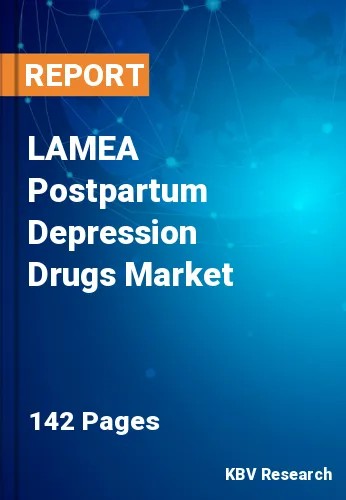The Latin America, Middle East and Africa Postpartum Depression Drugs Market would witness market growth of 11.2% CAGR during the forecast period (2024-2031).
The Brazil market dominated the LAMEA Postpartum Depression Drugs Market by Country in 2023, and would continue to be a dominant market till 2031; thereby, achieving a market value of $31.7 million by 2031. The Argentina market is showcasing a CAGR of 12.4% during (2024 - 2031). Additionally, The UAE market would register a CAGR of 10.9% during (2024 - 2031).

Adoption rates are influenced by screening practices for postpartum depression during prenatal and postnatal visits. Effective screening tools, such as the Edinburgh Postnatal Depression Scale (EPDS), help identify women at risk or experiencing symptoms, facilitating timely interventions, including pharmacological treatments. Adoption also depends on prescribing practices among healthcare providers. General practitioners, obstetricians, gynecologists, and psychiatrists may have varying comfort levels and expertise in prescribing antidepressants for postpartum depression.
Patient acceptance of these drugs is crucial for adoption. Factors influencing acceptance include perceived stigma associated with mental health disorders, concerns about medication safety during breastfeeding, and cultural beliefs about treatment preferences (e.g., preference for non-pharmacological approaches). Adoption rates are influenced by access to healthcare services, including the availability of mental health specialists, affordability of medications, and accessibility of follow-up care. Inadequate access to healthcare can hinder adoption as women may face barriers to receiving timely diagnoses and accessing pharmacological treatments.
Improved Drug Accessibility: With increased healthcare expenditure, there are more resources available for subsidizing medications and expanding healthcare coverage. This means that these drugs become more accessible to a broader segment of the population, including those who might have previously faced financial barriers. Increased funding typically improves healthcare infrastructure, leading to better diagnostic and treatment services for postpartum depression. More specialized clinics and healthcare providers can focus on maternal mental health, improving both diagnosis and treatment efficacy. As a result, the rising healthcare sector in LAMEA will fuel the demand for postpartum depression drugs in the upcoming years.
Free Valuable Insights: The Worldwide Postpartum Depression Drugs Market is Projected to reach USD 1.7 Billion by 2031, at a CAGR of 9.4%
Based on Treatment, the market is segmented into Pharmacotherapy, Hormonal Therapy, and Others. Based on Route of Administration, the market is segmented into Oral, Parenteral, and Others. Based on Distribution Channel, the market is segmented into Hospital Pharmacy, Retail Pharmacy, and Online Pharmacy. Based on Type, the market is segmented into Postpartum Anxiety, Postpartum Blues, Postpartum Obsessive-Compulsive Disorder (OCD), Postpartum Panic Disorder, Postpartum Post-Traumatic Stress Disorder (PTSD), and Postpartum Psychosis. Based on countries, the market is segmented into Brazil, Argentina, UAE, Saudi Arabia, South Africa, Nigeria, and Rest of LAMEA.
By Treatment
By Route of Administration
By Distribution Channel
By Type
By Country
Our team of dedicated experts can provide you with attractive expansion opportunities for your business.

